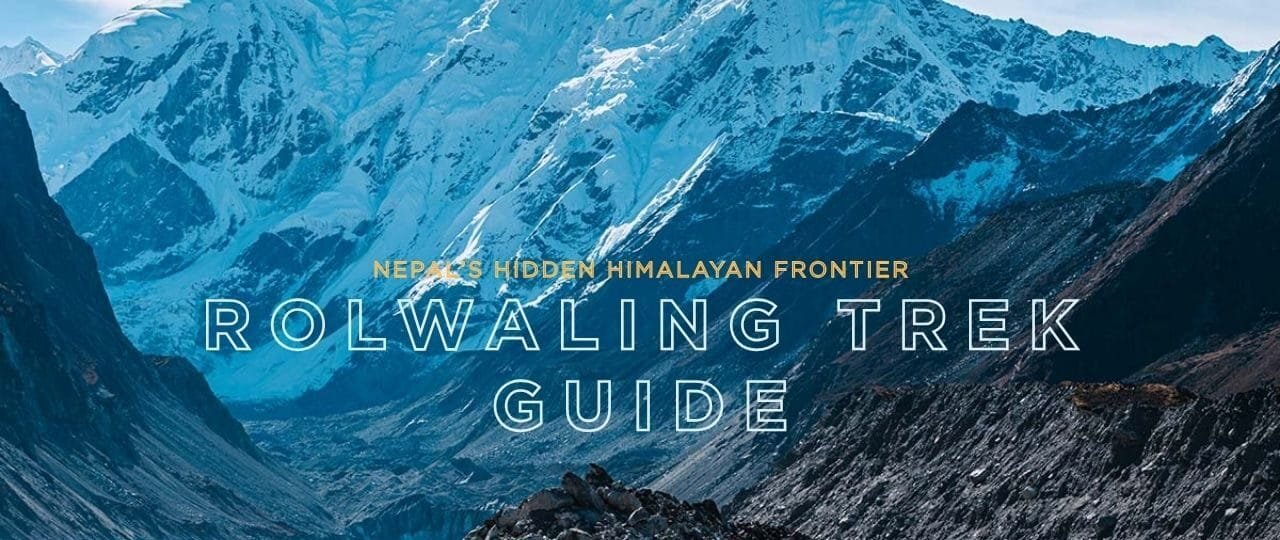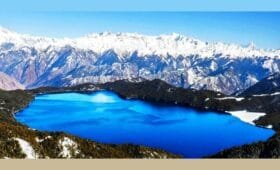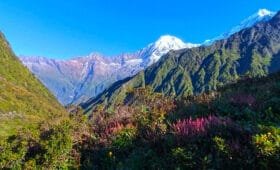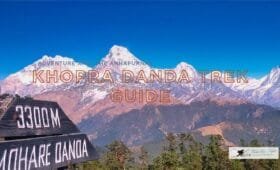If you’ve already scoured the popular Everest or Annapurna circuits and crave a less-traveled Himalayan gem, the Rolwaling Trek might be the adventure you seek. Encompassing the rugged Rolwaling Valley Trek route, this journey will lead you through pristine forests, dramatic gorges, and near-forgotten villages—ultimately bringing you face-to-face with some of the most dramatic peaks near the Tibetan border. Known for its offbeat charm, the Rolwaling Trek Itinerary delivers cultural immersion and raw natural wonders away from crowded trails.
This comprehensive article delves into every facet of the Rolwaling trek guide, from daily schedules and altitudes, typical Rolwaling Trek Costs, maps, best times to visit, and recommended gear. We’ll also tackle vital elements like permits, difficulty levels, guide requirements, and how to connect your trek with philanthropic efforts, such as volunteering with local communities through organizations like Volunteers Initiative Nepal (ViN). Whether you’re an experienced trekker pursuing a new challenge or a nature lover eager for solitude, the Rolwaling Trek might be your next Himalayan calling. Let’s explore the details of this secluded region, bridging tradition, ecology, and personal exploration.
Introduction
1. Introduction: Why the Rolwaling Trek?
The Rolwaling Trek beckons to those who appreciate pristine trails, fewer fellow hikers, and a tapestry of Nepal’s cultural mosaic. The route lies west of the Everest region, sandwiched between Gaurishankar and the sprawling Tibetan plateau. Only mountaineers targeting peaks like Gaurishankar or Melungtse for many decades trod these paths. But in recent years, the Rolwaling Valley Trek has blossomed, attracting trekkers who desire solitude and a direct vantage of grand Himalayan heights.
Statistic: According to the Nepal Tourism Board, fewer than 4,000 trekkers venture into Rolwaling each year—a fraction compared to the tens of thousands crowding Annapurna. This means the region retains an uncrowded vibe with simpler teahouses and an intimate glimpse of local life. Even so, the route’s altitude surpasses 5,700 meters in advanced expansions (like crossing the Tashi Lapcha Pass), rendering it a genuine expedition for those seeking a moderate-to-challenging level of adventure.
Quote:
“Rolwaling’s valleys appeared untouched by time. I loved weaving through villages where I was one of the few foreigners they’d hosted that year,” says Laura, a 29-year-old trekker from Canada who tackled the route last autumn.
Overview
2. Historical & Cultural Overview
The Rolwaling Valley Trek tradition stems from centuries of trade, herding, and religious pilgrimages across mountainous corridors. Local ethnicities—particularly Sherpa, Tamang, and occasionally Brahmin-Chetri in lower reaches—share a profound Buddhist influence. Ancient gompas (monasteries) and chortens dot the hilltops. Gaurishankar, a revered mountain in Hindu and Buddhist lore, forms a spiritual anchor for the region.
Historically overshadowed by the famed Everest region, Rolwaling’s remote settlements thrived on yak grazing and barley or potato farming. The government’s restricted-area policies limited mass tourism, preserving a distinctive cultural tapestry. Even with modernization creeping in, many villagers still rely on solar power, minimal roads, and weekly supply caravans. Trekking here grants an authentic immersion in Himalayan lifestyles predating large-scale tourism expansions.
Trek Itinerary
3. Key Highlights of Rolwaling Trek Itinerary
A standard Rolwaling Trek Itinerary extends ~14–17 days, though expansions to cross Tashi Lapcha toward Khumbu can push it to 20+. Here’s a typical blueprint for a classic route:
- Day 1–2: Kathmandu → Gongar / Simigaon (~2,000m)
A ~7–9 hour drive from Kathmandu to Gongar or Chetchet. A short trek leads to Simigaon, a Sherpa-influenced village. - Day 3–4: Simigaon → Dongang → Beding (~3,690m)
Trails climb gradually through lush forests, passing waterfalls and farmland. Bedding, the largest settlement in Rolwaling, has a centuries-old monastery. - Day 5–6: Beding → Na (~4,180m)
A shorter hike along the Rolwaling River leads to Na, a high-altitude pasture area. Many use Na for acclimatization, exploring side hikes to Yalung Ri or glacial vantage points. - Day 7–9: Exploring Tsho Rolpa Lake & Dormitory
Ascend near Tsho Rolpa (~4,580m), one of Nepal’s largest glacier lakes. If conditions allow, advanced trekkers venture further up the valley. Some do day hikes or expansions toward Trakarding Glacier. - Day 10–11: Return or Tashi Lapcha Attempt
Some hikers pivot back from Tsho Rolpa. More adventurous groups might attempt the Tashi Lapcha Pass (~5,750m), which links to Khumbu. This pass requires mountaineering gear and a climbing permit. - Day 12–14: Descending to Simigaon → Kathmandu
You retrace the path, soaking up new perspectives on farmland, forests, and the mesmerizing Gaurishankar ranges before driving back to Kathmandu.
Rolwaling Trek Duration hovers at ~14 days for the more straightforward approach, but expansions can be near 20 if crossing Tashi Lapcha or heading into Sagarmatha National Park. The route’s wilderness aspect ensures a raw, less-traveled ambiance.
4. Understanding the Rolwaling Trek Difficulty
Rolwaling Trek’s Difficulty is moderately high. The route’s terrain involves:
- Altitude: Trekkers can surpass 4,500m near Tsho Rolpa or 5,700m if crossing Tashi Lapcha.
- Remoteness: Minimal teahouses, fewer rescue options, and unpaved roads for initial drives.
- Terrain: Long daily ascents across rocky trails, with a scree or glacier near Tsho Rolpa.
Who Should Attempt: While standard routes to Tsho Rolpa Lake remain accessible to intermediate hikers, crossing Tashi Lapcha requires advanced skills and a climbing permit. Ensure robust fitness, previous Himalayan experience, or a licensed Rolwaling Trek guide.
5. Mapping Your Route: A Look at the Rolwaling Trek Map
Consulting a Rolwaling Trek Map is vital, as the region’s paths can be less marked:
- Simigaon (~2,000m): The main entry point after driving from Kathmandu.
- Dongang / Bedding: Gradual altitude gain through forested hills.
- Na Village (~4,180m): Base for exploring Tsho Rolpa Lake or minor side peaks.
- Tsho Rolpa (~4,580m): A glacier-fed lake overshadowed by the Rolwaling Himal range.
- Tashi Lapcha (~5,750m)**: Optional advanced pass crossing into Khumbu.
Route updates matter after the monsoon or winter closures—some trails shift or become landslide-blocked. Always confirm daily routes with a local guide or check local intel in Simigaon or Bedding.
Costing
6. How Much Does It Cost? Explaining the Rolwaling Trek Cost
The Rolwaling Trek Cost sits on the higher side relative to shorter, more commercial routes, mainly due to:
- Permits:
- Gaurishankar Conservation Area Permit: ~USD 30.
- TIMS card: ~USD 10–20 (depending on arranged or independent).
- A special restricted area permit is needed if crossing Tashi Lapcha.
- Transport:
- Bus or jeep from Kathmandu to Chetchet or Gongar: ~USD 10–50, depending on comfort level.
- Teahouse Lodging & Meals:
- ~USD 5–10 nightly for a basic room in remote areas.
- Meals ~USD 20–25 daily for basic Nepali or Tibetan-inspired cuisine.
- Guide / Porter (often mandatory in restricted areas):
- ~USD 25–40/day for a guide, ~USD 15–25/day for a porter.
- Camping Equipment (optional):
- Some segments might require tenting if teahouses are limited near Tsho Rolpa.
If using teahouses, budget ~USD 1,200–1,600 for a 14-day journey. If you choose a Rolwaling Trek Package with gear, staff, and an advanced pass crossing, expect higher costs (~USD 1,800+).
7. Booking the Right Rolwaling Trek Package
A Rolwaling Trek Package covers lodging, meals, permits, guide services, porters, and arranged transport. Some packages also include a climbing guide if you’re crossing Tashi Lapcha. Evaluate:
- Inclusions vs. Exclusions: Are gear rentals (tents, harnesses) included if crossing Tashi Lapcha?
- Group vs. Private: Groups lower costs but lock daily schedules, while private tours let you set the pace or add cultural side trips.
- Experience: Check your agency’s record. Confirm they use licensed guides who know the route intimately.
8. Securing Rolwaling Trek Permits
Rolwaling Trek Permits revolve around:
- Gaurishankar Conservation Area Permit (~USD 30).
- TIMS Card (~USD 10–20).
- Restricted Area Permits: If crossing Tashi Lapcha, a special permit is required (plus a climbing permit if tackling peak-level altitudes).
Check official or updated statuses from the Nepal Tourism Board or authorized agencies. Bring multiple passport photos, original passport, and visa details to expedite the process.
9. Rolwaling Trek Best Time: Seasons & Weather
Rolwaling Trek Weather can vary widely. The route’s isolation means fewer teahouses remain open year-round, so plan carefully:
- Autumn (Sept–Nov): Clear skies, mild day temps (~15–20°C at mid-altitudes), and cooler nights. It is peak season but still quieter than Everest or Annapurna.
- Spring (Mar-May): Blooming rhododendrons, comfortable daytime ~15°C. Occasional afternoon showers or haze. Crisp morning vistas of Gaurishankar or Melungtse.
- Winter (Dec–Feb): Nights above ~3,500m are sub-zero. Snow might close the Tsho Rolpa zone or Tashi Lapcha crossing, and fewer teahouses remain open.
- Monsoon (Jun–Aug): Heavy rainfall, muddy trails, potential landslides. Fewer trekkers, though lower vantage points are lush.
10. Hiring a Rolwaling Trek Guide
The route’s isolation and potential restricted-area status encourage travelers to use a Rolwaling Trek Guide. Even if you skip Tashi Lapcha, a guide offers:
- Local Knowledge: Minimizes confusion at path forks or newly formed landslide detours.
- Cultural Engagement: They can connect you with villagers, interpret local legends, or highlight hidden monasteries.
- Safety: If altitude sickness or accidents arise, immediate assistance is crucial.
- Permit Compliance: Agents or guides handle restricted zone paperwork if required.
Guide daily wages run ~USD 25–40, excluding tips. If crossing Tashi Lapcha, ensure your guide has an advanced mountaineering experience.
Tips
11. Preparation & Tips for Success
11.1 Physical Training
- Cardio: Running or cycling 3–5 times weekly for at least a month.
- Strength: Weighted squats, step-ups, or stair climbs replicate daily ascents.
- Altitude Familiarity: Do a mid-level Himalayan trek before tackling ~5,000m altitudes.
11.2 Essential Gear
- Layers: Thermal base, mid-layer fleece, down jacket, and waterproof shell.
- Footwear: Sturdy trekking boots, well broken in.
- Extras: Wate purifier, headlamp, personal first-aid kit, gloves, and beanie. If crossing Tashi Lapcha, climbing gear (crampons, rope) might be mandatory.
11.3 Health & Acclimatization
Rolwaling Trek’s Altitude can exceed 4,500m near Tsho Rolpa. If heading for Tashi Lapcha, you surpass 5,700m. Plan rest or acclimatization days (e.g., in Bedding or Na). Watch for headaches, dizziness, or insomnia—signs of altitude sickness. Descend if severe.
12. Stories from the Trail: Testimonials & Inspiration
Julian’s Reflection
Julian, a 34-year-old engineer from Germany, was struck by the deep quiet of Tsho Rolpa Lake’s surrounds: “I’ve trekked in Everest, but Rolwaling felt more mystical, less trodden. One morning, I watched the sunrise turn Gaurishankar gold. No crowds—just me and the hum of Himalayan winds.”
Local Gains
Communities along the route appreciate mindful travelers. “Every meal or teahouse night helps us sustain schools or footbridge upkeep,” shares Pasang, a lodge owner in Bedding. People value minimal footprints and are conscious of preserving Rolwaling’s environment and heritage for future generations.
FAQs
13. Seven Most Frequently Asked Questions
How long is the Rolwaling Trek Duration?
Typically, 14–17 days for a Tsho Rolpa route, or 20+ if crossing Tashi Lapcha into Khumbu.
What is the Rolwaling Trek Difficulty?
Moderately high. Steep ascents, altitudes over 4,000m, and remote conditions demand solid fitness.
How much does the Rolwaling Trek Cost?
Budget ~USD 1,200–1,600 for a 14-day teahouse trek (permits, guide, lodging, etc.). Suppose you want a Rolwaling Trek Package with Tashi Lapcha crossing; plan for ~USD 1,800+.
Which permits are needed for the Rolwaling Valley Trek?
Gaurishankar Conservation Area Permit (~USD 30), TIMS (~USD 10–20). A special restricted area or climbing permit if tackling Tashi Lapcha.
Is a guide mandatory?
It is not mandatory to climb Tsho Rolpa alone, but it is strongly recommended. Crossing Tashi Lapcha demands a licensed guide and advanced permits.
When is the Rolwaling Trek Best Time?
Autumn (Sept–Nov) and spring (Mar-May) for stable weather, moderate nights, and fewer logistical hurdles.
What about the route’s highest point?
Tsho Rolpa region is ~4,580m. Tashi Lapcha stands ~5,750m. Good acclimatization is crucial.
Conclusion
The Rolwaling Trek epitomizes a quintessential Himalayan escapade for those seeking raw, untouched trails away from mainstream tourist routes. Each day, from the luscious farmland around Simigaon to the ethereal Tsho Rolpa Lake and the possibility of crossing Tashi Lapcha Pass, fosters an intimate communion with nature and age-old Sherpa or Tamang traditions. Although physically demanding, the journey repays your stamina with vistas seldom seen by others.
Unite Your Trek with a Bigger Purpose—ViN’s Initiative
At Volunteers Initiative Nepal (ViN), we believe that each trek can become a vehicle for communal upliftment. By integrating your Rolwaling Valley Trek with philanthropic actions, you ensure that local communities thrive alongside your personal growth:
- Volunteer: Offer a few days teaching English, supporting local clinics, or aiding environmental projects near Simigaon or Bedding.
- Intern: Conduct social research or ecological studies that help shape better resource management for Himalayan communities.
- Donate: Channel resources toward local schooling, teahouse improvements, or footbridge reconstructions critical for daily life.
- Share: Encourage friends, colleagues, or family to adopt a philanthropic perspective in their travels, bridging adventure and empathy.
Namaste, and let’s champion a future where Himalayan trails become not just stepping stones for personal triumph but also catalysts for cross-cultural solidarity and sustainable progress. The Rolwaling Trek awaits your footprints—journey there with open hearts and an eagerness to bring mutual benefits.
More Information
Additional Info & Practical Tips
1. Seasonal Breakdown & Rolwaling Trek Weather
1.1 Autumn (Sept–Nov)
- Crisp, stable weather. Daytime ~15–20°C at mid-range altitudes, nights approach freezing above 3,500m. Perfect for panoramic views.
- It’s peak crowd season, though still overshadoweprimarymajor circuits, so it’s moderately quiet.
1.2 Spring (Mar-May)
- Rhododendrons and wildflowers color the trek. Afternoon storms or haze might appear, but mornings usually remain clear. Nights are moderately cold near Tsho Rolpa.
1.3 Winter (Dec–Feb)
- Sub-zero nights at Bedding or Na. Tsho Rolpa might freeze. If crossing Tashi Lapcha, heavy snow can hamper or close the pass.
- Some teahouses scale back operations, so plan carefully or carry a tent.
1.4 Monsoon (Jun–Aug)
- There are daily rains in lower valleys, risks of landslides, and intense humidity. Trekking remains possible but challenging. Visibility is limited. Few undertake the route, so lodging is emptier.
2. Tashi Lapcha Crossing Option
For adventurous souls continuing to the Everest region, Tashi Lapcha (~5,750m) demands mountaineering gear and specialized skills:
- Permit & Gear: Additional climbing permit if crossing the pass. Crampons, ropes, ice axes.
- Mountaineering Guide: Standard Rolwaling Trek guides might not suffice. A climbing-certified guide is needed.
- Timing: Early morning pass attempts in stable weather minimize avalanche or rockfall risk.
3. Cultural Immersion
3.1 Sherpa & Tamang Traditions
Villages like Bedding host centuries-old monasteries, prayer flags, and unique Tibetan-Sherpa dialects. Observing daily chores or rites fosters a more profound respect for mountain spirituality.
3.2 Lodging & Dining
Rolwaling Trek Accommodation typically comprises small teahouses. Dishes revolve around dal bhat, chapati, or Tibetan bread. Yak cheese or local soups appear at higher stops. Buying local crafts or produce helps sustain families.
4. Potential Challenges
- Minimal Infrastructure: Unlike Everest or Annapurna, you’ll find fewer teahouses, especially near Tsho Rolpa.
- Transportation: Bumpy roads to Chetchet or Gongar. Must remain flexible with timetables.
- Weather Extremes: Strong winds or storms near the lake or pass.
5. synergy with Volunteering via ViN
5.1 Pre/Post Trek
- Spare 2–3 days volunteering in or near Dolakha or Charikot, assisting local schools or health posts.
- Conduct environment workshops or trash-cleanup events for sustainable tourism.
5.2 On-Trek
While remote, some villages welcome short skill-sharing sessions (English basics, health awareness). You’ll need the help of a local interpreter or guide to coordinate.
6. Return & Reflection
After concluding the trek, many head back to Kathmandu to rest or indulge in city comforts. Reflect on how the experience impacted your perspective on Himalayan life and whether you’d do further philanthropic travel. Possibly share your story via personal blogs or social media, encouraging responsible tourism in lesser-known routes like Rolwaling.
7. Comparison with Other Restricted Treks
7.1 Rolwaling vs. Upper Mustang
Upper Mustang features desert-like landscapes, Tibetan culture, and official restricted permits. Rolwaling has more forested paths, glacial lakes, and fewer tourist amenities.
7.2 Rolwaling vs. Manaslu
Both are moderate–challenging, with restricted-area permits. Manaslu is more developed in teahouses, whereas Rolwaling remains wilder, especially near Tsho Rolpa.
8. Summarizing the Experience
Rolwaling Trek Route straddles cultural depth, rugged Himalayan vistas, and a sense of exploration overshadowed by no commercial crowds. Tsho Rolpa’s glacial basin is a pinnacle highlight, while the possibility of Tashi Lapcha crossing beckons advanced explorers. Each day fosters synergy between local interactions and the raw, mountainous environment.




